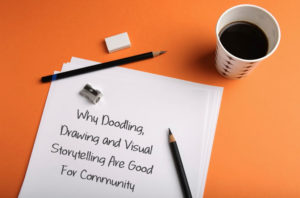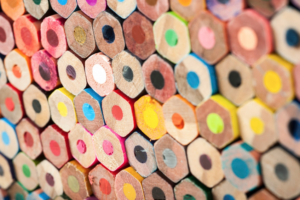By Amy Turner, The Community Roundtable
If we look back in history, we have been using visuals to communicate complex information for years through the use of diagrams, graphs, charts, etc. In today’s complex environment, we need visuals to help us make sense of the world. Raw data is too much of a sensory overload.
TheCR Network had a unique call with Nancy White, Founder of Full Circle Associates, to explore the use of collaborative drawing and visual storytelling across social media and community. Nancy learned that her sense of doodling at meetings was a way to help her pay attention, motivating her to develop a practice of both offline and online graphic facilitation through the use of visuals.
Six Fun Facts About Visuals:
- Visuals can help keep some people more focused, particularly those that have a difficult time in audio-only mode.
- Shared visuals can allow people to participate in different ways. Drawing is very social and can help move people out of their comfort zone, activating a different part of the brain to help improve engagement.
- Visuals can invite storytelling and meaning-making, whereas the printed sentence can stifle communication.
- Visuals can help organize our thoughts better than text in order to help people connect concepts.
- Adding beauty to text as a form of communication can actually make people stop and take a breath. This is especially important in blogging, allowing the visual to impact what you are trying to express.
- Comics as an online communication and engagement medium are becoming more popular. There are tools that allow people to create their own comics as a method of dialoguing with each other.
Visuals And Community:
- Visuals can draw people together. When people first went online, a common complaint was
 that it was difficult to form relationships due to the lack of body language. Emoticons were the early tools for self-expression. Now, we can embed images and draw together online, which can help us communicate better. Furthermore, video has introduced a whole new way to connect people online.
that it was difficult to form relationships due to the lack of body language. Emoticons were the early tools for self-expression. Now, we can embed images and draw together online, which can help us communicate better. Furthermore, video has introduced a whole new way to connect people online.
- Visuals help clarify communication. When someone writes a sentence, they think that their intent is clear and that it is received by the recipient as clear. However, when we start looking at visuals together, they are much more negotiable. People say: “Well, what did you mean by that?” One person could interpret it one way and another individual could interpret it another way. For some reason, individuals are willing to be open to interpretation within a drawing, but are much more black and white when it comes to text. If you are in a community where you are trying to make meaning (particularly in work communities where people are trying to design or problem-solve), a visual opens up a discussion whereas a statement may close it.
- Social reporting. Nancy explained that social reporting is “The act of people participating in the capturing of what is happening in a face-to-face event to share with the wider world or as a way to capture what happened.” This could be live blogging, live tweeting, graphically recording, photographing and/or videoing. The key is that it is a participatory process rather than something that is done by an outsider professionally. When a community can capture its own artifacts, some very interesting things can happen. When we participate in the creation of content around something we are learning or doing, it deepens our own learning and locks it in our brains. It is the process of participating in the conversation on one hand and making it concrete on the other. This connects people more than somebody doing it for them.
How do you use visuals to better impact your community and social channels?
